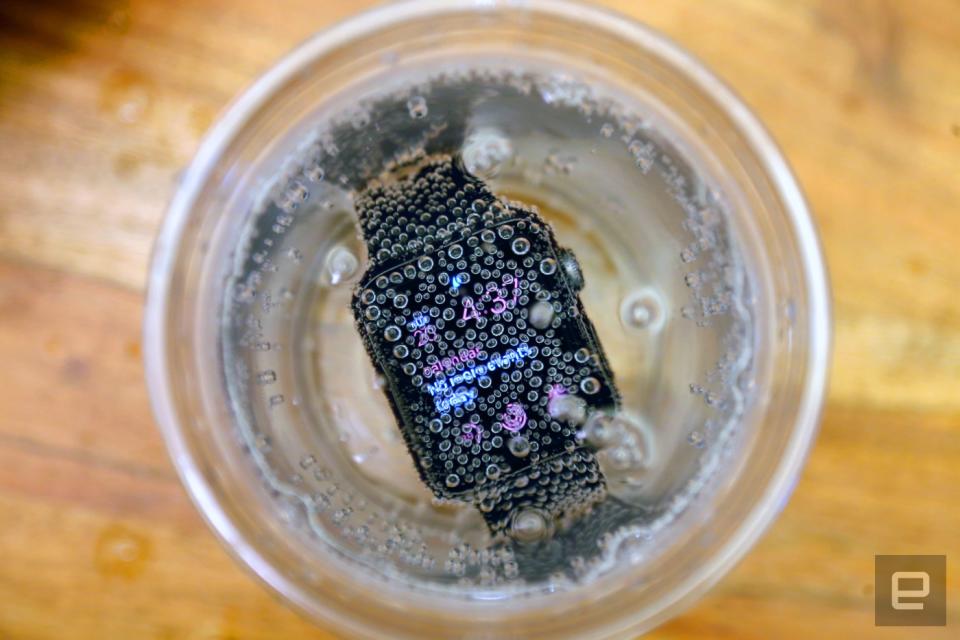Apple Watch Series 2 review (as written by a marathoner)
I like it as a smartwatch; less as a sports watch.
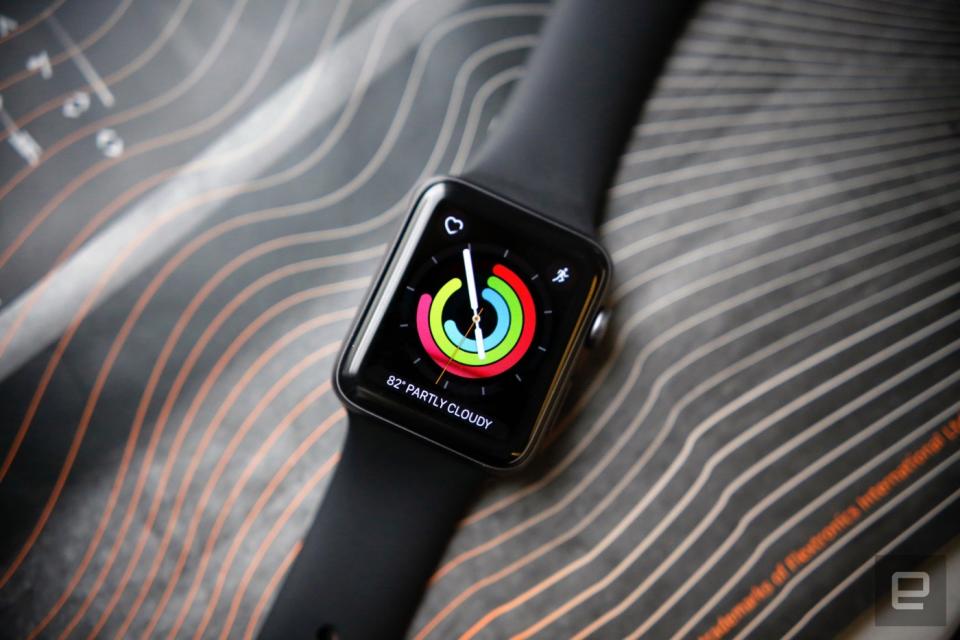
When the Apple Watch first came out last year, Engadget published not one but two reviews. There was the "official" review, which provided an overview of the device's features and, more important, attempted to explain who, if anyone, should buy it. Then there was a piece I wrote, focusing specifically on the watch's capabilities (actually, drawbacks) as a running watch. Although we knew that many readers would be interested in that aspect of the device, we were wary of derailing the review by geeking out about marathoning. This year, we needn't worry about that. With the new Apple Watch Series 2, the company is explicitly positioning the device as a sports watch. In particular, the second generation brings a built-in GPS radio for more accurate distance tracking on runs, walks, hikes, bike rides and swims. Yes, swims: It's also waterproof this time, safe for submersion in up to 50 meters of water. Beyond that, the other changes are performance-related, including a faster chip, longer battery life and a major software update that makes the watch easier to use. Even so, the first-gen version, which will continue to be sold at a lower price, is getting upgraded with the same firmware and dual-core processor. That means, then, that the Series 2's distinguishing features are mostly about fitness. And if you don't fancy yourself an athlete, we can think of an even smarter buy. For all intents and purposes, the Series 2 is identical to the original. Apple says the new models are nine-tenths of a millimeter taller, allowing them to accommodate bigger batteries. This was news to me: When I first saw a tableful of the Series 2 watches at the company's launch event earlier this month, I was sure the dimensions were unchanged. The screen sizes are otherwise the same -- 38mm and 42mm -- which means the respective bands will fit either generation of the device. So if you're one of the few who's already upgrading to your second Apple Watch, you can keep whatever bands you own. The watch is available in the same finishes as before too, except that an all-white (and apparently very durable) ceramic model has replaced last year's 18-karat gold model as Apple's highest-end "Edition" offering. Most of us are likely to go for the aluminum version, which comes in gold, rose gold, silver and space gray and starts at $369 ($399 for 42mm), or the stainless-steel model, which is offered in two colors and is priced from $549. If you're looking for something different, a special-edition Nike+ version of the Apple Watch is coming out next month. It comes in four choices of sporty bands, which are made from the same elastomer as Apple's own Sport strap, but are lighter-weight and easier to fasten. You'll also get two exclusive Nike watch faces and support for Siri voice commands -- something you won't otherwise see in Apple Watch apps made by third-party developers. Speaking of the sort, Nike's run app comes pre-installed, though it's also available in the App Store for anyone to download on any iOS or watchOS device. It will start at the same price as the Series 2. Which makes sense: It's basically the Series 2 with a few Nike extras thrown in. Across the lineup, the Series 2's screen is more than twice as bright as before, with an option to go up to 1,000 nits. But so long as you have auto-brightness turned on, you're unlikely to see the panel get that bright on its own -- not unless it's really, really bright outside. Finishing our tour, you still have the rotating "digital crown" on the upper-right edge, with another physical button below that. Those buttons each work slightly differently than they did before, but I'll get to that in a moment, in the software section. For now, here's the last thing I'll say on the "recap" front before I get to the new stuff: I suggest women and thinner-wristed people opt for the daintier 38mm model. Yes, it still looks like you have a computer strapped to your wrist (you do!), but I find it's small enough that it blends in with most outfits. As I write this, I'm training for my seventh marathon. When the first Apple Watch came out, I was unable to write Engadget's official review because I was on "vacation," running the Paris Marathon. I know a thing or two about running. And, as it happens, I also have strong feelings about sports watches. I don't actually ask much from them, though. More than anything, I need accurate distance and pace tracking, as well as enough battery power to last through my slow five-hour marathons. The first Apple Watch wasn't so good at the whole distance-tracking thing. But I had high hopes for this new model, which has its own GPS and GLONASS radios inside, meaning you no longer need to bring your phone with you to achieve the most accurate results. Though the GPS radio doesn't need to go through a calibration process, the built-in accelerometer does get smarter over time. In fact, Apple doesn't recommend attempting an indoor run before logging at least 20 minutes of outdoor running. That's because the watch needs time to learn your arm swing (and by extension, your stride). This might come in handy during some of your outdoor runs too: If you happen to lose your GPS signal, the accelerometer can help fill in the blanks, but it'll have an easier time doing that if it knows how you move. Indeed, when I tested the Series 2 alongside my trusty Garmin Forerunner 225, the distance gap was often very narrow. One day, I ran the 3.35-mile interior loop of Brooklyn's Prospect Park, and the two devices were off by 0.03 miles: 3.39 on the Garmin, and 3.42 on the Apple Watch. At first blush, this doesn't seem unusual: When I run with my training group, my friends' devices often show slightly different numbers at the end of a run. The problem is, even a seemingly minuscule distance gap can translate into a big difference in pace, by which I mean my average pace per mile as calculated at the end of the run. In the case of that 3.35-mile route, Garmin said I ran a 10:20 mile; Apple claimed my pace was 10:12. Needless to say, because Garmin did a better job estimating my distance around the park, I trust its pace calculation more too. That pace gap grew whenever I allowed myself to walk. On one workout where I did walk/run intervals, the Series 2 and my trusty Garmin Forerunner 225 were off by 0.11 miles over roughly two hours and 15 minutes, or nine seconds on pace. The discrepancies widened further when I did these walk/run intervals on shorter routes. In one approximately 42-minute workout, the two watches were 0.09 miles off, resulting in a whopping 17-second difference in the average pace. Throughout, Apple's readouts suggested I ran farther and faster than I believe I did. (Update: Corrected for a 1.2-second difference in total time, the difference in pace for that 42-minute run was 16 seconds, not 17. Still, not good.) Interestingly, Apple's calorie-burn estimate was always similar to that of both the Garmin and the treadmill at my gym. The heart-rate readouts during my cross-training classes were also on target (meaning: in the range I expected). I found all of this was true of the original Apple Watch too. In any case, because the issue here is the pace calculation, and not whether I ran a few hundredths of a mile less than the watch said I did, the Series 2 could still be a good fit for walkers, hikers and casual cyclists. It might even work for sometimes-runners who just want a rough idea of how far and fast they're going. But I would not recommend it for someone like me who trains for events where speed matters. I want to know: Am I capable of holding the pace I would need to break my marathon record? I don't want Apple giving me false hope there. Believe me, I'm just as disappointed as you are. Especially since the distance and pace tracking seem to suffer when I switch to walking. Some of the fastest, fittest runners I know slow down or walk sometimes. Any sports watch worth its salt should take that into account. Speaking of which, I know I sound like a broken record repeating this in every story I write about the Apple Watch, but would it kill the company to add a run/walk mode? Or interval workouts of any kind -- even distance? These seem to me like fairly common, in-demand features, and what's more, you can find a lot of them on cheaper devices. Anyhow, if you want them badly enough, you'll download a third-party running app, like RunKeeper, which are often more full-featured. The battery life here is at least decent. Apple says the watch can last through five hours of continuous GPS activity. Having done some testing, though, I believe that's actually a conservative estimate. After a two-hour-and-fifteen-minute run with auto-pause and no heart-rate monitoring, I was down to 78 percent. That would have been plenty to last me through the rest of the day and into the evening, and then it was easy enough to recharge while I was in the shower. Just as important, the fact that I lost only 22 percent of my charge during such a long run means perhaps I really could finish a five-hour marathon without depleting the battery. I also like Apple's slick-looking Activity app for the iPhone. As on other running apps, you can see a map of your route, along with the weather conditions you ran through that day. Here, though, you also get color-coded lines showing where you sped up and slowed down. It's a nice touch, but can we get some mile markers on the map too, Apple? Oh, and an elevation chart would be nice. Heck, if Apple wanted to study established players like Garmin, it could even throw in things like minimum, maximum and average cadence and steps per minute. Nike, meanwhile, is known for its cool photo feature. Some sort of picture tool seems like a no-brainer here, especially with the iPhone's cameras being as good as they are. I'm not saying the average user will demand all these things, but without them, why would a serious (and brand-loyal) runner like me switch? Especially if you could get a more feature-rich sports watch for the same price or less? There's one thing I can't argue with: The Series 2 watch really is waterproof. Whereas last year's model was splash-resistant, the new model can handle immersion in up to 50 meters of water. Engadget's senior mobile editor Chris Velazco took one for a dip on the Jersey Shore, and he didn't break it. The watch is still "ticking," so to speak. What's more, Apple added two swim workouts -- pool and open-water-swimming -- which the company said it tested on 700 swimmers of different abilities, for a total of around 1,500 workouts. Depending on the kind of workout you choose, the Apple Watch uses different techniques to track your distance. In a pool, you can program the length of the pool, at which point Apple can detect when you've turned around for another lap. In open-water swimming, the watch's GPS radio pulls in your location every time your hand is above water to track where and how far you've gone. In addition to counting pool laps, the watch can calculate your average pace and even detect the kind of stroke you're doing. That last part matters because it has a bearing on calorie burn. There's a reason most of us don't enjoy the butterfly: It's hard! Regardless of the swim workout you choose, the watch will automatically lock the screen to prevent accidental "touches" (water can sometimes register as a tap). When you're out of the water, rotate the digital crown to unlock the screen and eject water from the speakers. What happens there is that the speakers use their own vibration to push out any remaining water. It's a neat solution, considering the speakers were the one part of the device that couldn't be totally sealed. You'll probably also enjoy the retro arcade-esque beeps that the watch emits while releasing water. On the other hand, you might also be disappointed to find that the water doesn't burst from the watch's orifices like an open fire hydrant. You might not even see a trickle. The Series 2 arrived about the same time as watchOS 3, the third and best version of Apple's smartwatch software. And by the best, I mean this is the operating system the company should have launched on the original Apple Watch. In addition to being faster, watchOS 3 has a far more intuitive user interface, with a revamped layout that generally requires less swiping and tapping than it used to. Now you can press the side button to open a brand-new "Dock," where you can swipe horizontally through thumbnails of recent and favorite apps. Just as convenient, these previews refresh in the background. So if it's my Activity Rings I'm after, I can see them at a glance and get a rough sense of how I'm doing. Depending on how much detail I need in that moment, I might not even need to open the app. That side button serves a second purpose, by the way: An optional "SOS" feature allows you to hold down that key to call emergency services in whatever country you happen to be in. Unlike some other features in watchOS 3, this is one you actually have to opt into to use. That's probably a good thing -- we wouldn't want anyone accidentally and unknowingly calling the police. Another intuitive thing: You can swipe right and left on the home screen to cycle through whatever watch faces you've loaded onto the device. Indeed, there are some new faces on offer, and you can find them all in a brand-new face gallery in the Watch app. Adding and removing faces is intuitive, as is reordering them and selecting different accent colors (oh, the options there). My only complaint here is that sometimes when I would swipe left and right on the home screen, my swipes wouldn't register at first; I'd have to try again before I could get to the watch face I wanted. Also, though I like the watch faces available, I wish I had more options. Why not open this feature up to outside developers? You may have gathered already that Activity is one of my most-used Watch apps. And it's not just because I'm a bit of a fitness nut. Even on days when I'm not running, there's something addictive about completing my three color-coded Activity Rings. On days when I forget to wear my watch, I regret that I don't get credit for all my New York speed-walking. All that said, there was apparently room for the app to get better. With watchOS 3, Apple added social sharing, so you can see how far along your friends are in meeting their daily fitness goals. Once you've sent a connection request and your pal has accepted, you can check up on them by swiping left to a second screen in the Activity app. You'll be notified when your buddies finish a workout, earn an achievement or close their rings. You can also send text messages from inside the app, with so-called Smart Replies designed specifically for activity sharing (and smack talk). Lastly, the Activity app is now optimized for wheelchairs, with an option to track wheelchair push counts instead of steps. In a similar vein as the Activity app, watchOS 3 ushers in a new "Breathe" app that encourages users to stop what they're doing and breathe deeply. Just take a minute to inhale and exhale as you watch an on-screen graphic contract and expand. Though I was annoyed to find that Breathe notifications can't be permanently disabled, the app did come in handy on a recent subway commute, where I was otherwise feeling irritated by all the pushy people around me. If meditating is your cup of tea, you can adjust both the target breathing rate and the length of the session. If it isn't, you can dismiss the notifications -- for the day, at least. Meanwhile, in Apple's Workouts app you, can now assign names to miscellaneous workouts so that you don't have to settle for the "Other" label. Think: yoga, belly dancing, et cetera. There's that auto-pause feature I mentioned earlier, which works for both indoor and outdoor runs. (You'll feel a "tick" on your wrist when the stopwatch pauses itself.) Additionally, you can mark segments in any workout by double-tapping the display. And you can hit Quick Start for your most common workout types -- another example of how watchOS 3 often requires fewer taps than it used to. A lot of the other new stuff in watchOS 3 matches what you'll find in iOS 10. In Messages, you can send so-called Tapbacks, which let you respond to a message by adding a thumbs-up, heart or other pictorial reaction by tapping rather than hitting "reply." That's particularly useful on a watch, where you can't type anything and probably want to minimize scrolling through dozens of lines of emoji. Speaking of replies, you also get a "Scribble" feature, which is exactly what it sounds like: You can draw letters and hearts on the screen with your finger. For now, that feature is available only in English and Traditional and Simplified Chinese, but it wouldn't surprise me if Apple incrementally added support for more languages. Rounding out the list of Messages features, you get access to those animated full-screen effects that make texting so addictive on iOS 10. Other features borrowed from iOS (and even macOS): a new Home app, where you can control any smart home devices based on Apple's HomeKit standard. There's a new Reminders app and complication. Find My Friends is now on Apple Watch for the first time. And, as I discussed in my macOS Sierra review this week, you can use watchOS 3 to unlock your Sierra Mac. In theory, setting this up simply requires having two-factor authentication enabled and checking off a box in your system settings, but I wasn't able to get the feature to work until I reset my iCloud password. Hopefully you have better luck there. Throughout, the Series 2 feels fast -- gone are the days when you'd have to wait several seconds for an app to load. That's partly because watchOS 3 itself is faster and more efficient, but it's also because of the second-gen watch's new, faster "S2" chip. All told, Apple says the dual-core CPU inside can deliver up to a 50 percent performance gain, while the GPU is up to twice as fast as on last year's watch. The Series 2 does indeed feel materially faster than the original. Apps load quickly, it's easy to swipe left into second screens, and the background updates have been super-helpful. I occasionally notice some lag when scrolling up and down; maybe that's something Apple can address in next year's software update. Even so, watchOS 3 and the Series 2 in particular are vast improvements when it comes to sheer speed and efficiency. Though Apple says the Series 2 watches are slightly taller to accommodate a larger battery, the company lists the battery life as the same for the 38mm and 42mm models: up to 18 hours. In my day-to-day use, I found I could leave the house early in the morning -- say, between 7 and 8 -- and return some 14 hours later with as much as half a charge left. That's assuming I used the watch intermittently, checking in occasionally to peek at my Activity Rings and dismiss those incessant "Stand" reminders. You still need to charge the watch once a day, but that never really bothered me. It's not like I'm going to sleep with that big thing on my wrist, so why not just let it rest on its magnetic charging disc overnight? In a sense, the new Apple Watch's greatest competition is actually ... the old Apple Watch. The original model is still being sold under a new name, the Series 1, and at a lower starting price: $269 (make that $299 if you want the larger 42mm version). What's more, the Series 1 now ships with the same dual-core processor as the Series 2, not to mention watchOS 3. That means the differences between the two models are few: The newer edition has a 1,000-nit screen instead of a 450-nit one; built-in GPS; and waterproofing. There will always be folks who want the latest and greatest (or who want to go for a swim), but I predict that this holiday season, many people will opt for the cheaper model instead. Beyond that, it's not helpful to say that the Series 2 competes with every other smartwatch out there; let's instead focus on devices that are primarily as sports watches but also do typical smartwatch things, like handle notifications. Samsung has the $180 Gear Fit 2, which we called Samsung's best wearable yet, thanks to its GPS, automatic workout tracking and stylish design. The problem? It's Android-only for now. For $250, Garmin's Vivosmart HR+ has GPS, a waterproof design, support for cycling and a battery rated for eight days total or 13 hours of GPS activity. And, yes, it works with iOS. You might also be considering the Moto 360 Sport (now $200), but as we found in our review, the Android Wear watch doesn't function nearly as well when paired with an iPhone. The Series 2 is a good smartwatch, but not the best sports watch. I always appreciated the availability of apps for the Apple Watch, but I'm particularly fond of the revamped layout in watchOS 3 -- everything is easier to find, often with less tapping and swiping than before. But considering that the Series 2 is being positioned as more of a sports watch, and that the GPS radio is one of the few things distinguishing it from the older Series 1, it's disappointing that the pace calculation is often off the mark. Apple's own Activity and Workout apps could benefit from more features too -- things like mile markers on running maps, elevation charts and interval settings. In any case, if all you want is distance tracking (meaning pace is irrelevant to you), the Series 2 will make a fine companion on walks, hikes and maybe even casual jogs. But it isn't precise enough for athletes in training. Basically, it's a very stylish, feature-rich fitness tracker. For most people, the less expensive Series 1 is a better bet, since it has the same processor and OS as the Series 2 and works just as well as a smartwatch. Really, I would recommend the newer model only to people who swim. Even then, as with running, it's probably best for recreational use. Apple might feature serious-looking athletes in its ads, but ultimately, the Series 2 isn't robust enough for those people to give up their dedicated sports watches just yet.
Design

As a sports watch
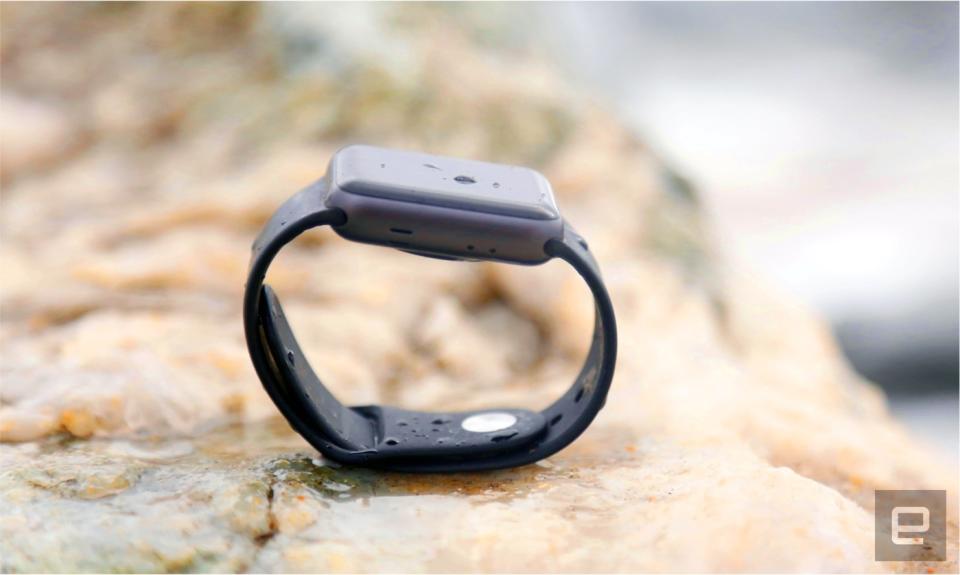

Swimming
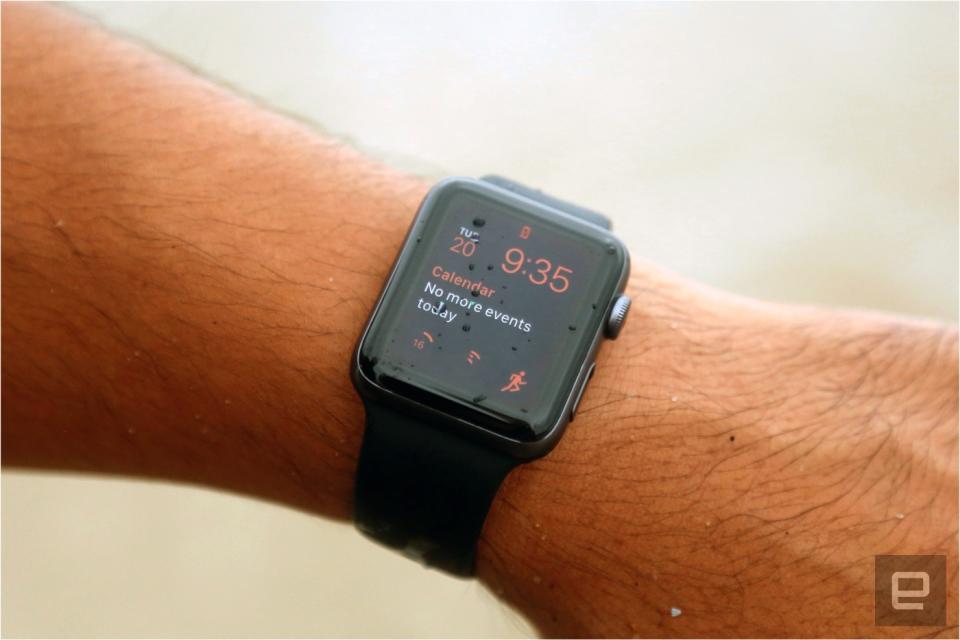
As a smartwatch
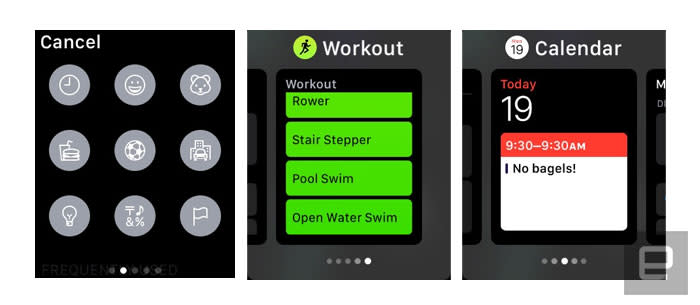

Performance and battery life

The competition
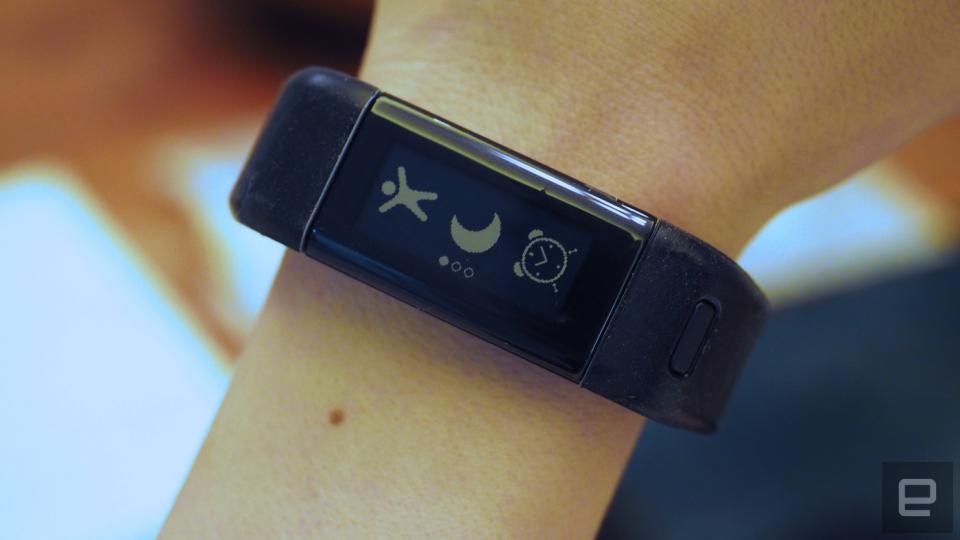
Wrap-up
